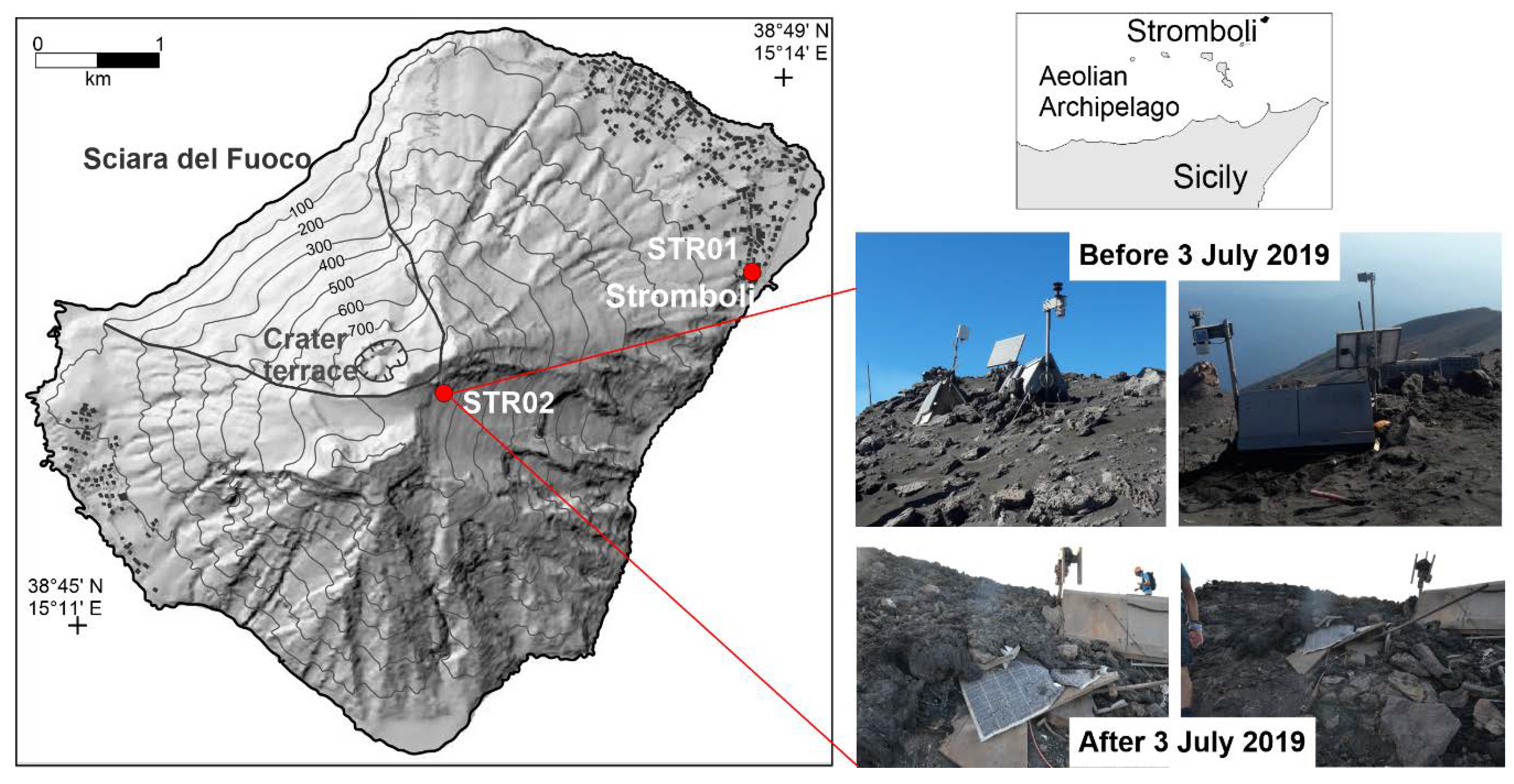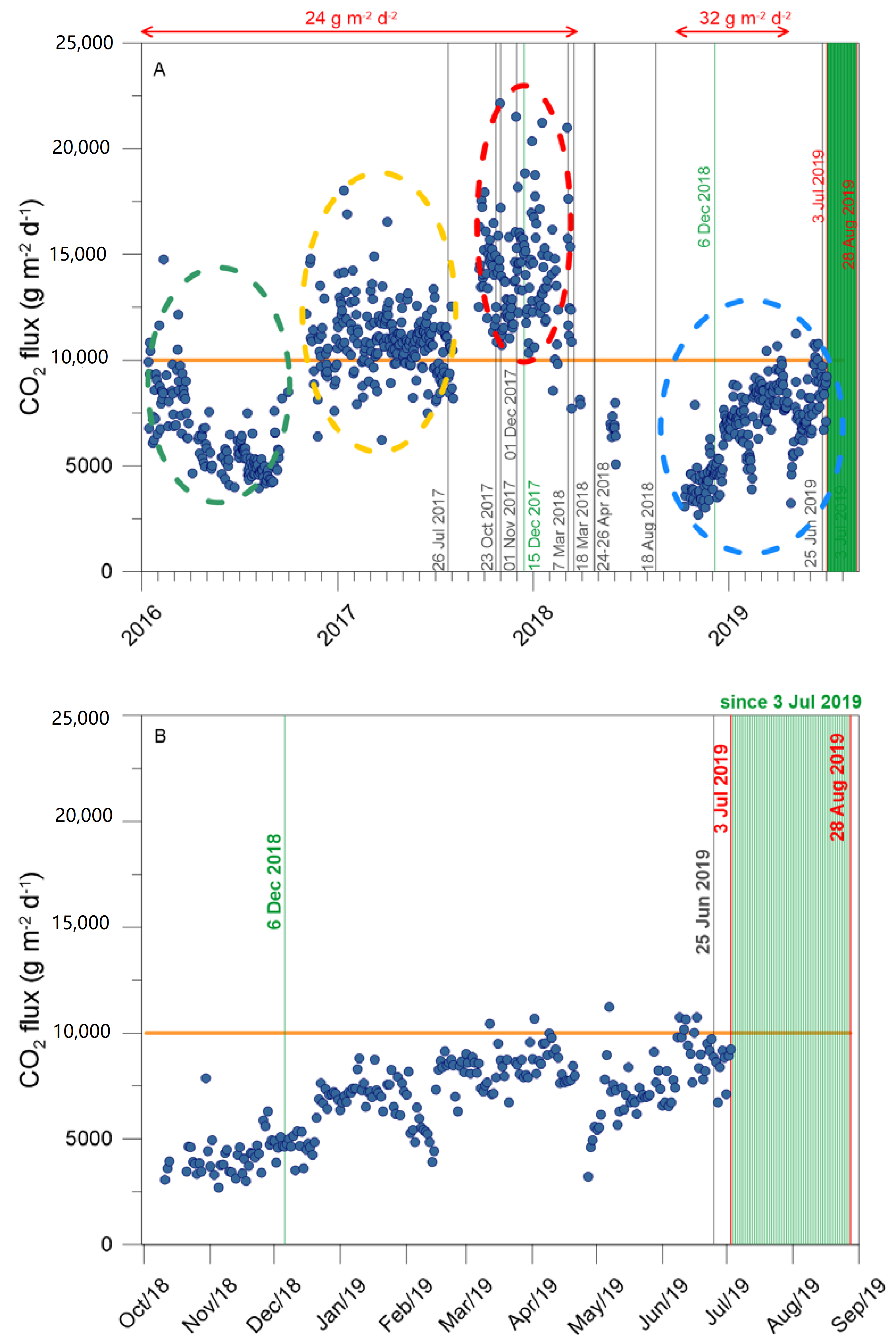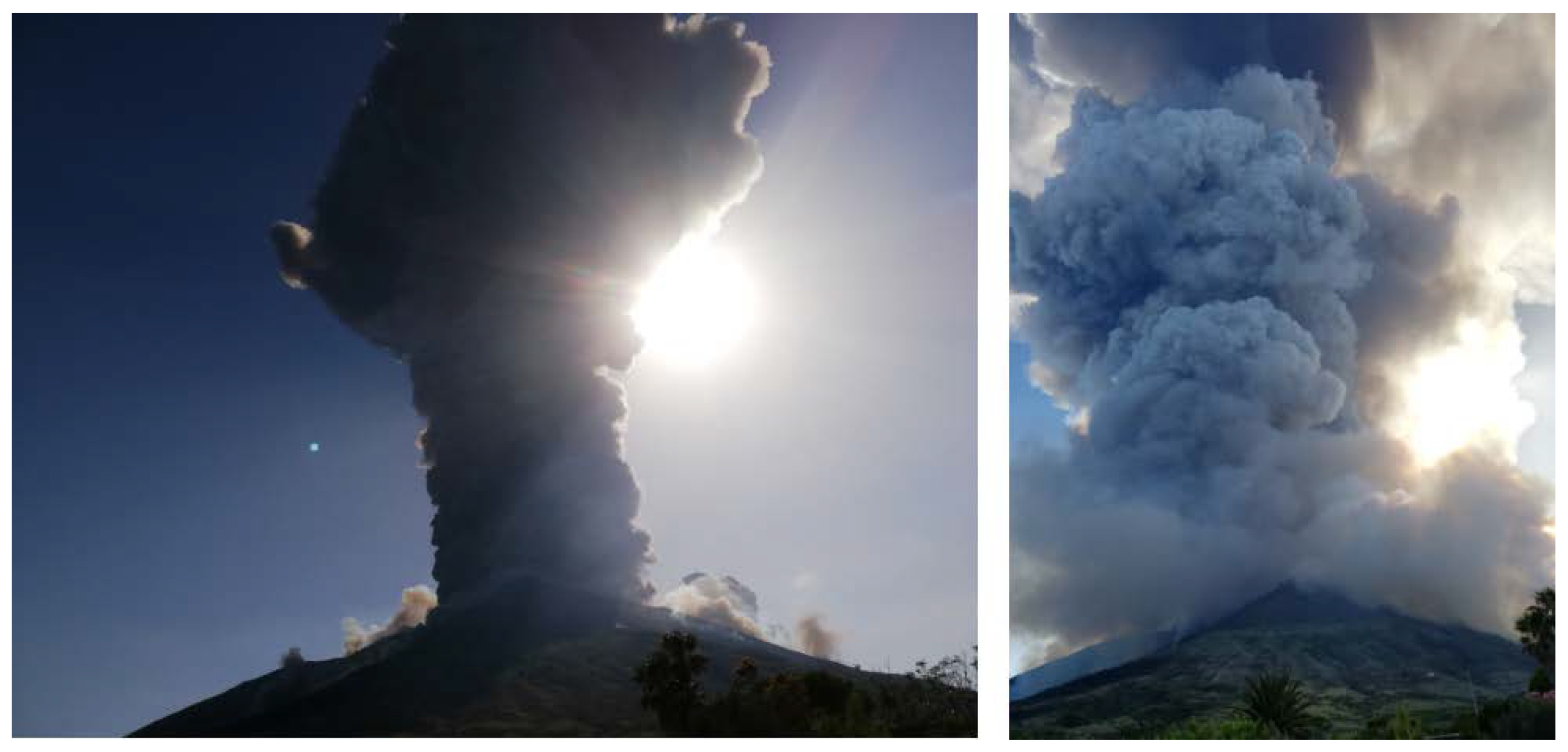Changes in CO2 Soil Degassing Style as a Possible Precursor to Volcanic Activity: The 2019 Case of Stromboli Paroxysmal Eruptions
Abstract
1. Introduction
2. Recent Volcanological Activity: The 2019 Paroxysmal Events (3 July and 28 August)
3. Methods: CO2 Fluxes Geochemical Networks
4. Discussion
5. Conclusions
- A long-lasting modification, characterized by a slow and continuous increase of CO2 flux, which indicates that the volatiles pressure in the shallow plumbing system increased over time [11];
- Transient modifications, characterized by abrupt changes of CO2 degassing rate, indicating many different pulses of new un-degassed magma arriving in the shallow plumbing system;
Author Contributions
Funding
Acknowledgments
Conflicts of Interest
References
- Martini, M.; Giudicepietro, F.; D’Auria, L.; Esposito, A.M.; Caputo, T.; Curciotti, R.; De Cesare, W.; Orazi, M.; Scarpato, G.; Caputo, A.; et al. Seismological monitoring of the February 2007 effusive eruption of the Stromboli volcano. Ann. Geophys. Italy 2007, 50, 775–788. [Google Scholar] [CrossRef]
- Inguaggiato, S.; Vita, F.; Rouwet, D.; Bobrowski, N.; Morici, S.; Sollami, A. Geochemical evidence of the renewal of volcanic activity inferred from CO2 soil and SO2 plume fluxes: The 2007 Stromboli eruption (Italy). Bull. Volcanol. 2011. [Google Scholar] [CrossRef]
- Harris, A.; Stevenson, D.S. Thermal observations of degassing open conduits and fumaroles at Stromboli and Vulcano using remote sensed data. J. Volcanol. Geotherm. Res. 1997, 76, 175–198. [Google Scholar] [CrossRef]
- Stevenson, D.S.; Blake, S. Modelling the dynamics and thermodynamics of volcanic degassing. Bull. Volcanol. 1998, 60, 307–317. [Google Scholar] [CrossRef]
- Aiuppa, A.; Bertagnini, A.; Metrich, N.; Moretti, R.; Di Muro, A.; Liuzzo, M.; Tamburello, G. A model of degassing for Stromboli volcano. Earth Planet. Sci. Lett. 2010, 295, 195–204. [Google Scholar] [CrossRef]
- Inguaggiato, S.; Pecoraino, G.; D’Amore, F. Chemical and isotopical characterization of fluid manifestations of Ischia Island (Italy). J. Volcanol. Geotherm. Res. 2000, 99, 151–178. [Google Scholar] [CrossRef]
- Inguaggiato, S.; Martin-Del Pozzo, A.L.; Aguayo, A.; Capasso, G.; Favara, R. Isotopic, chemical and dissolved gas constraints on spring water from Popocatepetl (Mexico): Evidence of gas-water interaction magmatic component and shallow fluids. J. Volcanol. Geotherm. Res. 2005, 141, 91–108. [Google Scholar] [CrossRef]
- Inguaggiato, S.; Hidalgo, S.; Beate, B.; Bourquin, J. Geochemical and isotopic characterization of volcanic and geothermal fluids discharged from the Ecuadorian volcanic arc. Geofluids 2010, 10, 525–541. [Google Scholar] [CrossRef]
- Inguaggiato, S.; Vita, F.; Cangemi, M.; Mazot, A.; Sollami, A.; Calderone, L.; Morici, S.; Mariana, P.; Paz, J. Stromboli volcanic activity variations inferred from observations of fluid geochemistry: 16 years of continuous monitoring of soil CO2 fluxes (2000–2015). Chem. Geol. 2017. [Google Scholar] [CrossRef]
- Giudicepietro, F.; Calvari, S.; Alparone, S.; Bianco, F.; Bonaccorso, A.; Bruno, V.; Caputo, T.; Cristaldi, A.; D’Auria, L.; De Cesare, W.; et al. The 2017–2018 eruptive phase of Stromboli volcano: Insights into the mechanism of major explosions. Remote Sens. 2019, 11, 1813. [Google Scholar] [CrossRef]
- Inguaggiato, S.; Vita, F.; Cangemi, M.; Calderone, L. Increasing summit degassing at Stromboli volcano and relationships with volcanic activity (2016–2018). Geosciences 2019, 9, 176. [Google Scholar] [CrossRef]
- Rosen, J. Volcanic fumes warn of imminent eruptions. Science 2016. [Google Scholar] [CrossRef]
- Vita, F.; Inguaggiato, S.; Bobrowski, N.; Calderone, L.; Galle, B.; Parello, F. Continuous SO2 flux measurements at Vulcano island, Italy. Ann. Geophys. 2012, 55, 301–308. [Google Scholar] [CrossRef]
- Inguaggiato, C.; Vita, F.; Diliberto, I.S.; Calderone, L. The role of the aquifer in soil CO2 degassing in volcanic peripheral areas: A case study of Stromboli Island (Italy). Chem. Geol. 2016. [Google Scholar] [CrossRef]
- Inguaggiato, S.; Diliberto, I.S.; Federico, C.; Paonita, A.; Vita, F. Review of the evolution of geochemical monitoring, networks and methodologies applied to the volcanoes of the Aeolian Arc (Italy). Earth Sci. Rev. 2018, 176, 241–276. [Google Scholar] [CrossRef]
- Rizzo, A.L.; Federico, C.; Inguaggiato, S.; Sollami, A.; Tantillo, M.; Vita, F.; Bellomo, S.; Longo, M.; Grassa, G.; Liuzzo, M. The 2014 effusive eruption at Stromboli volcano (Italy): Inferences from soil CO2 flux and He-3/He-4 ratio in thermal waters. Geophys. Res. Lett. 2015, 42, 2235–2243. [Google Scholar] [CrossRef]
- Rizzo, A.; Grassa, F.; Inguaggiato, S.; Liotta, M.; Longo, M.; Madonia, P.; Brusca, L.; Capasso, G.; Morici, S.; Rouwet, D.; et al. Geochemical evaluation of the volcanic activity changes observed during the 2007 eruption at Stromboli (Aeolian islands, Italy). J. Volcanol. Geotherm. Res. 2009, 182, 246–254. [Google Scholar] [CrossRef]
- Inguaggiato, S.; Rizzo, A. Dissolved helium isotope ratios in ground-waters: A new technique based on gas-water re-equilibration and its application to Stromboli volcanic system. Appl. Geochem. 2004, 19, 665–673. [Google Scholar] [CrossRef]
- Capasso, G.; Carapezza, M.L.; Federico, C.; Inguaggiato, S.; Rizzo, A. Geochemical monitoring of the 2002–2003 eruption at Stromboli volcano (Italy): Precursory changes in the carbon and helium isotopic composition of fumarole gases and thermal waters. Bull. Volcanol. 2005, 68, 118–134. [Google Scholar] [CrossRef]
- Landi, P.; Francalanci, L.; Pompilio, M.; Rosi, M.; Corsaro, R.A.; Petrone, C.M.; Nardini, I.; Miraglia, L. The December 2002–July 2003 effusive event at Stromboli volcano, Italy: An insight into the shallow plumbing system by petrochemical studies. J. Volcanol. Geotherm. Res. 2006, 155, 263–284. [Google Scholar] [CrossRef]
- Bertagnini, A.; Métrich, N.; Landi, P.; Rosi, M. Stromboli volcano (Aeolian Archipelago, Italy): An open window on the deep-feeding system of a steady state basaltic volcano. J. Geophys. Res. 2003, 108, 2336. [Google Scholar] [CrossRef]
- Giudicepietro, F.; López, C.; Macedonio, G.; Alparone, S.; Bianco, F.; Calvari, S.; De Cesare, W.; Delle Donne, D.; Di Lieto, B.; Esposito, A.M.; et al. Geophysical precursors of the July–August 2019 paroxysmal eruptive phase and their implications for Stromboli volcano (Italy) monitoring. Sci. Rep. 2020, 10, 10296. [Google Scholar] [CrossRef] [PubMed]
- Chiodini, G.; Cioni, R.; Guidi, M.; Raco, B.; Marini, L. Soil CO2 flux measurements in volcanic and thermal areas. Appl. Geochem. 1998, 13, 543–552. [Google Scholar] [CrossRef]
- Brusca, L.; Inguaggiato, S.; Longo, M.; Madonia, P.; Maugeri, R. The 2002–2003 eruption of Stromboli (Italy): Evaluation of the volcanic activity by means of continuous monitoring of soil temperature, CO2 flux, and meteorological parameters. Geochem. Geophys. Geosyst. 2004, 5, Q12001. [Google Scholar] [CrossRef]
- Carapezza, M.L.; Inguaggiato, S.; Brusca, L.; Longo, M. Geochemical precursors of the activity of an open-conduit volcano: The Stromboli 2002–2003 eruptive events. Geophys. Res. Lett. 2004, 31, L07620. [Google Scholar] [CrossRef]
- Madonia, P.; Brusca, L.; Inguaggiato, S.; Longo, M.; Morici, S. Variations of soil temperature, CO2 flux, and meteorological parameters. In Learning from Stromboli and its 2002–2003 eruptive crisis. Geophys. Monogr. Ser. 2008, 182, 269–277. [Google Scholar]
- Inguaggiato, S.; Jacome Paz, M.P.; Mazot, A.; Delgado Granados, H.; Inguaggiato, C.; Vita, F. CO2 output discharged from Stromboli Island (Italy). Chem. Geol. 2013. [Google Scholar] [CrossRef]
- Cardellini, C.; Chiodini, G.; Frondini, F. Application of stochastic simulation to CO2 flux from soil: Mapping and quantification of gas release. J. Geophys. Res. 2003, 108, 2425. [Google Scholar] [CrossRef]
- Chiodini, G.; Granieri, D.; Avino, R.; Caliro, S.; Costa, A.; Werner, C. Carbon dioxide diffuse degassing and estimation of heat release from volcanic and hydrothermal systems. J. Geophys. Res. 2005, 110, B08204. [Google Scholar] [CrossRef]
- Werner, C.; Cardellini, C. Comparison of carbon dioxide emissions with fluid upflow, chemistry, and geologic structures at the Rotorua geothermal system, New Zealand. Geothermics 2006, 35, 221–238. [Google Scholar] [CrossRef]
- Inguaggiato, S.; Calderone, L.; Inguaggiato, C.; Mazot, A.; Morici, S.; Vita, F. Long-time variation of soil CO2 fluxes at the summit of Vulcano Island (Italy). Bull. Volcanol. 2012, 74, 1859–1863. [Google Scholar] [CrossRef]
- Bakalis, E.; Theo, J.; Mertzimekis, P.N.; Zerbetto, F. Temperature and Conductivity as Indicators of the Morphology and Activity of a Submarine Volcano: Avyssos (Nisyros) in the South Aegean Sea, Greece. Geosciences 2018, 8, 193. [Google Scholar] [CrossRef]
- Bakalis, E.; Theo, J.; Mertzimekis, P.N.; Zerbetto, F. Breathing modes of Kolumbo submarine volcano (Santorini, Greece). Sci. Rep. 2017, 7, 46515. [Google Scholar] [CrossRef] [PubMed]
- Mega Mirko, S.; Allegrini, P.; Grigolini, P.; Latora, V.; Palatella, L.; Andrea, R.; Vinciguerra, S. Power-Law Time Distribution of Large Earthquakes week ending. Phys. Rev. Lett. 2003, 90, 18. [Google Scholar] [CrossRef]
- Scafetta, N.; Grigolini, P. Scaling detection in time series: Diffusion entropy analysis. Phys. Rev. E 2002, 66, 36130. [Google Scholar] [CrossRef]
- Tommasi, P.; Baldi, P.; Chiocci, F.L.; Coltelli, M.; Marsella, M.; Pompilio, M.; Romagnoli, C. The Landslide Sequence Induced by the 2002 Eruption at Stromboli Volcano. Landslides 2005. [Google Scholar] [CrossRef]




© 2020 by the authors. Licensee MDPI, Basel, Switzerland. This article is an open access article distributed under the terms and conditions of the Creative Commons Attribution (CC BY) license (http://creativecommons.org/licenses/by/4.0/).
Share and Cite
Inguaggiato, S.; Vita, F.; Cangemi, M.; Calderone, L. Changes in CO2 Soil Degassing Style as a Possible Precursor to Volcanic Activity: The 2019 Case of Stromboli Paroxysmal Eruptions. Appl. Sci. 2020, 10, 4757. https://doi.org/10.3390/app10144757
Inguaggiato S, Vita F, Cangemi M, Calderone L. Changes in CO2 Soil Degassing Style as a Possible Precursor to Volcanic Activity: The 2019 Case of Stromboli Paroxysmal Eruptions. Applied Sciences. 2020; 10(14):4757. https://doi.org/10.3390/app10144757
Chicago/Turabian StyleInguaggiato, Salvatore, Fabio Vita, Marianna Cangemi, and Lorenzo Calderone. 2020. "Changes in CO2 Soil Degassing Style as a Possible Precursor to Volcanic Activity: The 2019 Case of Stromboli Paroxysmal Eruptions" Applied Sciences 10, no. 14: 4757. https://doi.org/10.3390/app10144757
APA StyleInguaggiato, S., Vita, F., Cangemi, M., & Calderone, L. (2020). Changes in CO2 Soil Degassing Style as a Possible Precursor to Volcanic Activity: The 2019 Case of Stromboli Paroxysmal Eruptions. Applied Sciences, 10(14), 4757. https://doi.org/10.3390/app10144757




